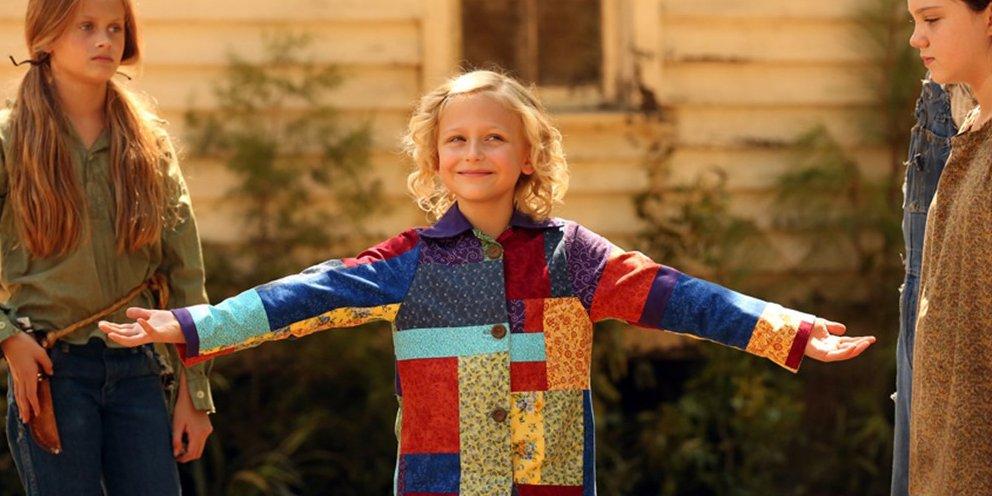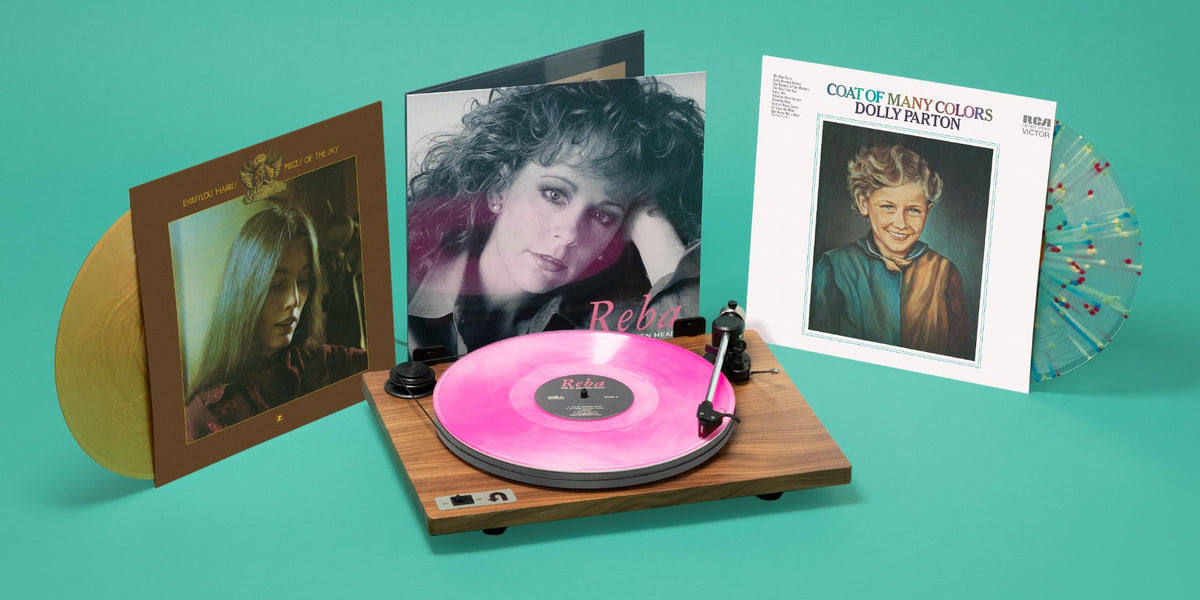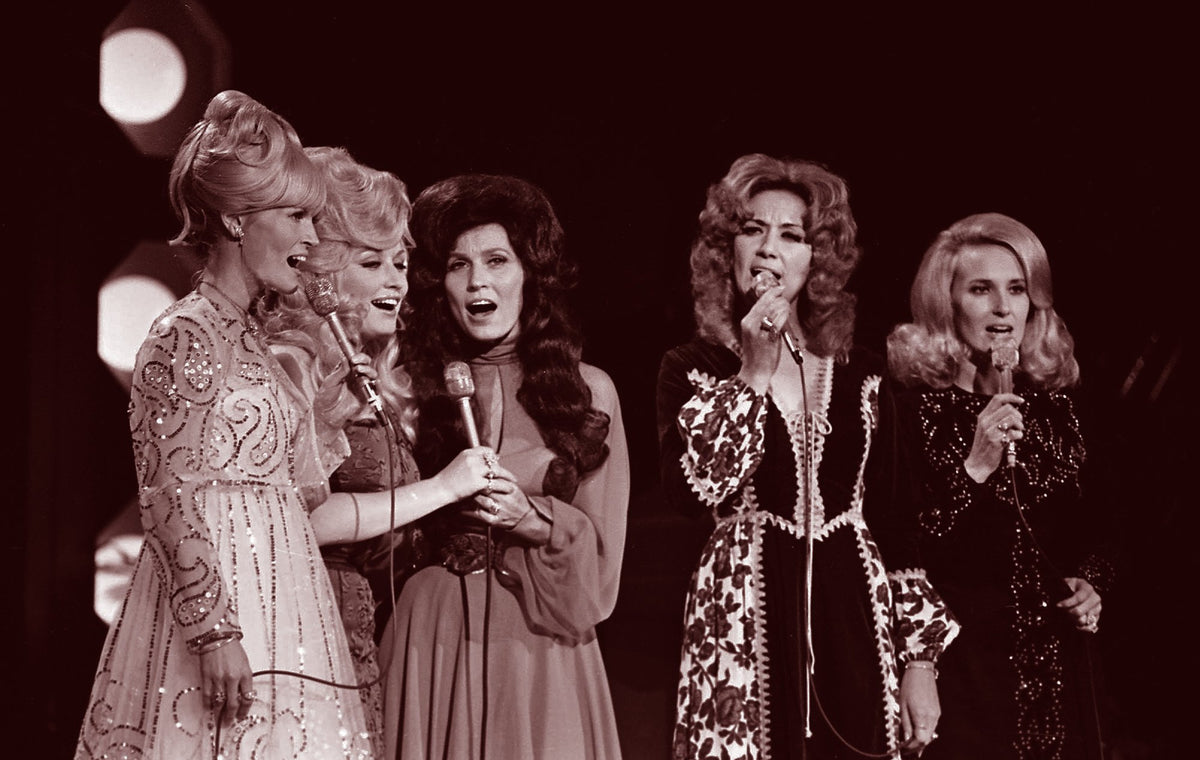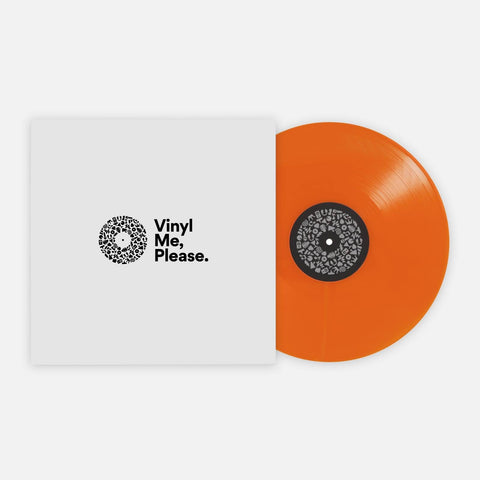Dolly Parton’s Graceful Breakout
How ‘Coat Of Many Colors’ Built a Legend’s Foundation
It was six years and 11 solo albums after the release of Dolly Parton’s solo breakthrough, Coat of Many Colors, that she sat down with Barbara Walters on ABC Evening News on December 6, 1977. After guiding Walters and the camera crew through her tour bus while gushing about the wonders of a life on the road for a restless woman from humble beginnings, she wielded her nylon-string guitar and serenaded Walters, and the American public, with an intimate rendition of the album’s opening and title track.
The song was written on the back of a dry cleaning receipt in 1969 while she was touring with her early-career duet partner, country singer and variety show TV host Porter Wagoner, and it tells the story of a coat that Parton’s mother, Avie Lee Owens, made for her when she was a young girl. Dolly Rebecca Parton was born in 1946, the fourth of 12 children, and raised in a one-room cabin in the Smoky Mountains of Eastern Tennessee. Because her father, a sharecropper named Robert Lee Parton Sr., couldn’t afford to pay the doctor, he exchanged a sack of cornmeal for her delivery. Years later, as the song goes, with the chill of late-fall encroaching, Dolly without a coat to keep her warm on her way to and from school, and her family with no money to buy one, her mom sewed a coat from a box of multicolor rags someone had gifted the family.
A skilled seamstress and quilter, Dolly’s mother often tried to match scrap colors so as to make her patchwork undetectable, but she knew her daughter required a less subtle approach. “This was going to be a colorful coat with no apologies,” Parton wrote in her 1994 autobiography. As she crafted the garment, little Dolly’s mom told her the Bible story of Joseph and his similar many-hued garb, suggesting her newest item of clothing might bring her “good luck and happiness.” Thrilled by her special, handmade coat with biblical ties and aching to show it off, she wore it to school, only to be teased and laughed at by the other kids. While Dolly and her family grew up in an area with plenty of other poor folks, she and her siblings had recently started attending a bigger school — and that meant being among more economically advantaged students.
“I couldn’t understand it / For I felt I was rich / And I told ’em of the love / My momma sewed in every stitch,” Parton sings with a retroactive bewilderment and a hint of dignified rage.
A genuine-as-can-be country tune, “Coat of Many Colors” centers gentle finger-picking and Dolly’s alive, steadfast soprano, buttressed by an unwavering bassline and punctuated by the bountiful Appalachian folk harmonies that pulse like a heartbeat through the album’s 10 tracks. The song is, above all else, a painful, hard-learned parable in recognizing worth where it counts, living authentically in your values and standing unwaveringly beside them in the face of cruelty cast by people who won’t take the time to understand. On numerous occasions, she’s cited “Coat of Many Colors” as her favorite out of her 956-song career — “not just because it’s a song, because it’s very personal to me; it’s really kind of a philosophy of life, really,” she once explained onstage after performing the song.
With all this in mind, it’s particularly grating that, just minutes after Parton strummed the last chord of “Coat of Many Colors” on the news that evening, Walters immediately chose to scrutinize Parton’s appearance. After tossing around the word “hillbilly,” invasively questioning the “realness” of Parton’s physique (“Is it all you?”), even requesting she stand up during the interview for a better view of her body, Walters says, “You don’t have to look like this; you’re very beautiful. You don’t have to wear the blonde wigs. You don’t have to wear the extreme clothes. Right?”
It’s easy in hindsight, watching this moment play out over 40 years later, to feel your blood boil while clocking the contempt — the internalized misogyny, the implicit classism — dripping from the worldly, straight-laced, college-educated interviewer sitting across from the mountain-bred woman with a lot of talent and a bit of luck. But it’s unfair to blame Walters entirely. She was, after all, representing a fairly common attitude within her program’s audience. For much of Parton’s career, to a certain sector of the mainstream American public not so unlike those schoolyard bullies who sneered at her coat many years ago, Dolly was nothing but a caricature, a punchline, a gaudy hillbilly with a rotating cast of wigs, a cut crease and a set of big tits.
“It’s certainly a choice. I don’t like to be like everyone else. I’ve often made the statement that I would never stoop so low as to be fashionable; that’s the easiest thing in the world to do,” Dolly, 31 at the time, retorted. “I’m very real, where it counts, and that’s inside, and as far as my outlook on life, and the way I care about people, and the way I care about myself, and the things that I care about. But I just chose to do this — show business is a money-making joke, and I’ve just always liked telling jokes.” You can almost hear her wink.
“But do you ever feel that you’re a joke? That people make fun of you?” Walters pressed on.
“Oh, I know they make fun of me. But actually, all these years, the people have thought the joke was on me, but it’s actually been on the public,” Dolly smiled, warmly. “I know exactly what I’m doing, and I can change it at any time. I make more jokes about myself than anybody, because I am sure of myself as a person; I’m sure of my talent; I’m sure of my love for life and that sort of thing. I’m very content. I like the kind of person that I am. So I can afford to piddle around and do-diddle around with makeups and clothes and stuff, because I am secure with myself.”
In the face of thinly veiled vitriol, Dolly didn’t bat a false eyelash. In fact, she doubled down with self-assuredness, poise and even arguably underserved kindness. Her grace is startling, almost baffling, but after all, she’d been developing a thick skin toward astringent half-baked judgments since back when she wore that beloved coat of hers to school. And while the ignorance may’ve only grown in scale and scope as she grew to pursue a life in country music, so too did the depth of her talent, the support of her fans, the catalog of her songs and her inexplicable elegance in fielding it all.
Dolly Parton wrote her first song, “Little Tiny Tasseltop,” about her corncob doll around age six, and never stopped. The ancient ballads and folk tunes and the Smoky Mountain folklore her mom shared around the house instilled a love of song and storytelling deep within her bones. While absorbing all the sadness, joy, pain, love and color of a rural mountain upbringing that would one day turn up again all over her songbook, she began singing at the church where her grandfather was a preacher and made herself a makeshift guitar from an old mandolin and two bass guitar strings. Around age eight, Dolly’s Uncle Lewis, a talented guitar player himself, finally gifted her a real guitar, a little Martin. In 1956, when she was 10, her Uncle Bill Owens drove her to Knoxville to perform on a local variety show called “The Cas Walker Farm and Home Hour,” backing her up on his big Gretsch hollowbody. The crowd adored her, and not long after, Walker booked her as a regular act on his show, paying her $5 a show out of his pocket.
With her Uncle Bill close by her side — making industry connections in Knoxville and Nashville, co-writing songs with Dolly and backing her up on guitar — she kept performing and writing, and by 13, she recorded her first single, “Puppy Love,” a sweet-as-candy rockabilly number that played on local radio airwaves. That very same year, she landed a guest appearance on the Grand Ole Opry. Bill talked Opry star Jimmy C. Newman into giving Dolly one of his regular Saturday night slots, and next thing she knew, she was being introduced by a handsome, young Johnny Cash. (“I thought he was the sexiest thing that ever was,” she wrote, describing the evening in her 2020 book Dolly Parton, Songteller: My Life in Lyrics.)
During the rest of her teenage years, she and Uncle Bill traveled back and forth in various cars in various states of dysfunction to and from Music City, tapes in tow, trying to get just about anyone to listen. Meanwhile, Dolly begrudgingly finished up her schooling and became the first member of her family to graduate from high school in June 1964. The day after her graduation ceremony, she hopped on a bus to Music City and promised herself she wouldn’t come home until she had something to show for it. She spent her days looking for gigs, writing songs, working part-time jobs and walking up and down Music Row, only to get turned down by nearly every major record label in Nashville. Her young, twinkling soprano register made her prone to being written off as a “girly” pop vocalist or a teenybopper performer, as opposed to the country singer and songwriter she knew she was deep down. Even once she did get signed in 1967 to the independent label Monument Records, label owner Fred Foster saw potential in her future as a bubbly pop act and, accordingly, had her perform cheery singles written for her by other songwriters. Her debut full-length, Hello, I’m Dolly, features quippy, darling tracks like the Curly Putman-penned “Dumb Blonde” and her first commerically minded song of her own, “Something Fishy.” While she recalls being grateful for the break, development and resources she found in Foster and at Monument, it’d soon become clear that she had more to say.
Her fame continued to grow when 40-year-old star Porter Wagoner, with over 25 hits to his name, hired a 21-year-old Dolly that summer to be the “girl singer” in his band. By 1969, they were on the rise to become one of the most successful country duos in the business. Guided by his mentorship and gaining her own industry acumen by the day, she became a member of the Grand Ole Opry cast, joined Wagoner’s touring company, signed to label giant RCA, and started turning out both solo and duet records at a breakneck speed. While her early partnership with Wagoner was pivotal to her musical, artistic and career growth at the time, it often resulted in the misconception that she was simply a pretty voice, a pretty face and a pretty accessory to Porter, underscoring her unimaginable lyricism and songwriting abilities. She’d eventually grow tired of being the “girl singer,” longing to spread her butterfly wings on her own, and be faced with a hell of a time trying to do so, but in the meantime, she didn’t waste a second in honing her voice, quietly establishing herself as one of Nashville’s rising songwriting powerhouses via a mounting pile of her work. Between her debut in February 1967 and October 1971, she racked up songwriting credits faster than anyone could count and released six more solo albums. Then, Coat of Many Colors came along and springboarded Dolly Parton’s trajectory into the stratosphere where she remains today.
Coat of Many Colors was predominantly recorded between March and April of 1971, when Parton was 25 years old, in RCA Studio B in Nashville and produced by the pivotal country producer Bob Ferguson. Parton penned all but three of the 10 songs found on the album; “If I Lose My Mind,” “The Mystery of the Mystery” and “The Way I See You” were written by Wagoner.
Though it strikes a sharp contrast to the album’s earnest and innocent opener, the soulful, funky second track, “Travelin’ Man,” is similarly a chronicle of a certain aspect of mountain life, though this time with a bit more fantasy. When Parton was growing up, companies like Fuller Brush and Watkins would send salesmen to solicit the sales of kitchen items and other goods to mountain wives. The song’s narrator is a bored daughter, dreaming between rip-roaring guitar licks of running off with one of these men, against the wishes of her disapproving mother. It’s not until the last verse that Dolly, ever one for a wisecrack, reveals that the reason for mom’s disapproval was because her mom was in love with the traveling man herself. “Oh, that traveling man was a two-time lover / He took my love, then he took my mother,” Parton hollers.
Most of the album, however, matches the heartfelt tone “Coat of Many Colors” sets. “My Blue Tears,” a longtime favorite from Dolly’s catalog that’s been rerecorded by everyone from Goldie Hawn, to bluegrass icon Rhonda Vincent, to Dolly’s own brother, Randy Parton, features a heartbroken soul begging a bluebird to find another place besides their windowsill to sing their joyful song and let them wallow in sadness. “If I Lose My Mind” outlines the forever-relatable feeling of wanting nothing other than to crumble in your mother’s arms after a breakup and subsequent breakdown: “Mama, can I be your little girl again? / I need you now even more than I did then.” With its weepy pedal steel guitar, “She Never Met A Man (She Didn’t Like)” pleads for a lust-struck lover not to leave for someone who’s undiscerning and meaningless in her love.
What’s most apparent, though, across Coat of Many Colors — through the pain, the work, the heartbreak and even the cruelty — is Parton’s complete, undying adoration for life and the people in it. “Early Morning Breeze,” a track that subtly veers into psychedelic folk, is a spiritual meditation that observes and appreciates the simplicity of an early morning walk through a meadow and a moment of prayer. Album closer “A Better Place To Live” takes time to imagine what an actively kinder world would look like. Bold and brilliant “Here I Am,” in retrospect, serves as a much more definitive, and more fitting, introduction to her self-driven rise than a simple “Hello, I’m Dolly.” Sung almost exclusively in Dolly’s unhinged all-out belt, the song’s a pipe-showcasing testament to the simple power of showing up: lending a hand, offering an understanding ear, knowing how much love you’ve got to give and shelling it out indiscriminately.
After performing “Coat of Many Colors” live, many years after the song came out, Dolly remembered the healing she felt upon its release. “When that song first became a hit, it lifted a lot of hurt off me,” she said, recalling how moving it was to hear from the outpouring of people that resonated with its message and shared similar pain that they were carrying around from their own childhood. If it wasn’t clear by the end of “Coat of Many Colors” alone, the rest of the album — and the rest of Parton’s entire career, for that matter — proves that a rock-solid comfort in your own skin, a strong compass for love in its many-present forms and finding good folks to share it with are the forces that render you nearly impenetrable to callousness or judgment. And it’s something Dolly’s found through her music, too, right alongside the rest of us.
Amileah Sutliff is a New York-based writer, editor and creative producer and an editor of the book The Best Record Stores in the United States.
Related Articles
Join the Club!
Join Now, Starting at $36Pages







